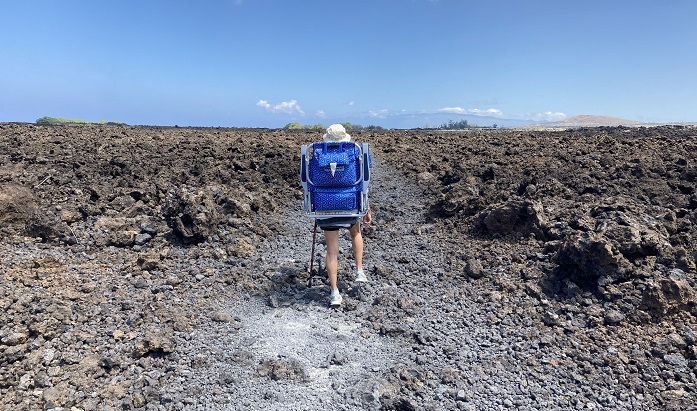
Join Thor and me as we trek across a lot of lava on Hawaii’s Big Island and learn about the geology of the islands.
NOTE: Thor and I decided on a quick trip to Hawaii’s Big Island to stretch out summer a bit as our gray, rainy Pacific Northwest winter was closing in. The airline and all venues in Hawaii are being super careful with Covid precautions, and it was a wonderful getaway. If you didn’t catch my blog series about our first Big Island trip, it started April 24, 2021, and you can catch up on the full adventure, including a volcano, petroglyphs, snorkeling with wild dolphins, and a night swim with manta rays. And I promise I will finish the Retro Italy Vacation series soon.
You can’t let a little thing like hiking across broiling, sharp lava fields keep you from some amazingly serene coves for picnics and snorkeling! The native Hawaiians apparently ran barefoot over the jagged lava fields on the Big Island, and I am grateful for shoes.
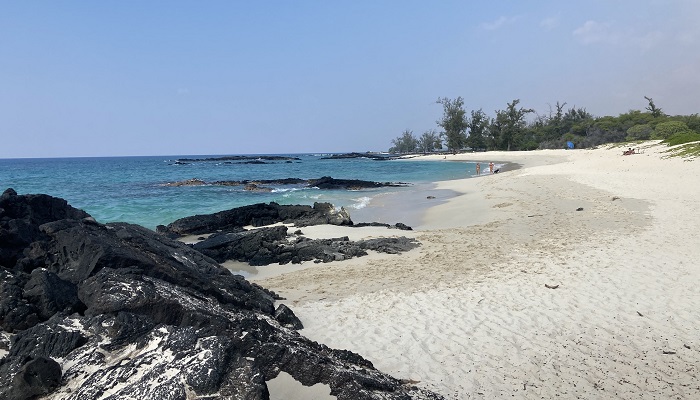
The Big Island is the youngest of the Hawaiian chain, and its still-active volcano is adding fresh lava flows to the existing layers. I appreciate the dramatic contrasts of black lava, greenery, and blue sea and sky, as well as the sea’s clarity without a lot of soil runoff. Thor, as a geologist, adds a further dimension to our rambles. Today he’ll weigh in on volcanic matters, but first a bit of Hawaiian history and beliefs.
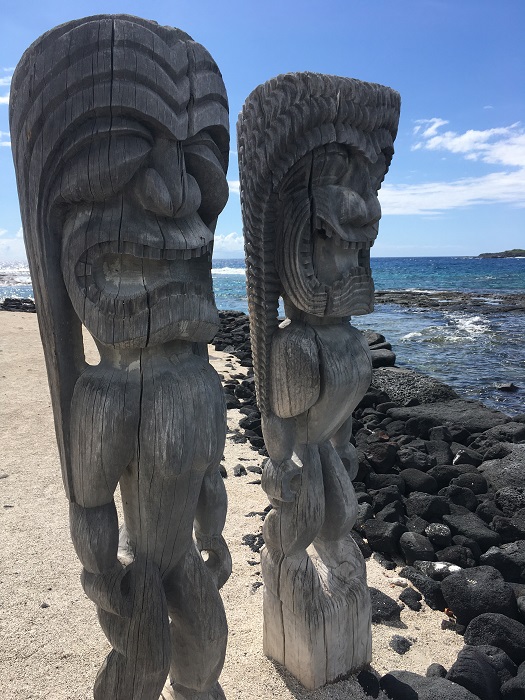
The guardian figures at the Place of Refuge (overlooking our favorite snorkeling spot), make sure that the proper order and reverence to the old deities are maintained. Madame Pele, goddess of volcanoes, is still given a lot of respect here. And rightly so, since she is temperamental and throws molten lava around when she is displeased. After wiping out a housing development on the east side below the Kilauea crater, she took a nap, everyone breathed easy…

…until September 29, 2021, right after Thor and I arrived on the island for our second visit. The Kilauea crater had started erupting again, with fountaining lava, and soon vog (irritating volcantic fog) became an issue once more. To find fresher air, we headed northwest along the coast. Here, older lava flows layer over the landscape.

Looking north toward Mauna Kea, to the older volcano that seems to be sleeping. This is the mountain that Thor described as like “a big plop of gooey batter,” spreading massive flanks to create the island landscape.
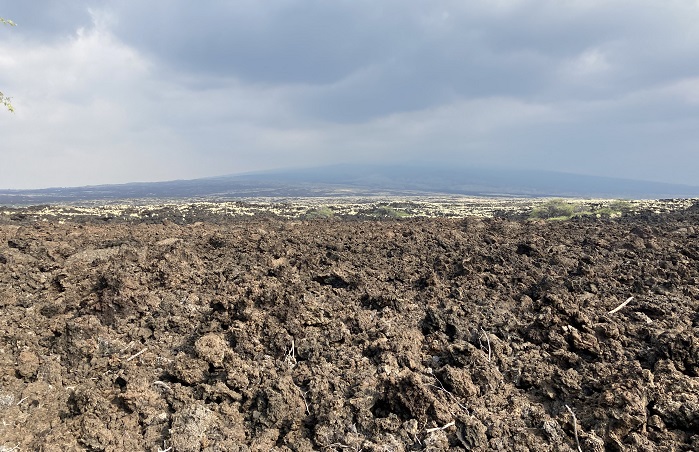
Along Saddle Road that crosses the island east to west, you drive through old ash mounds from Mauna Kea. Their shapes suggest to me that they might have inspired the native hei’au lava-rock mounds built on sacred sites.
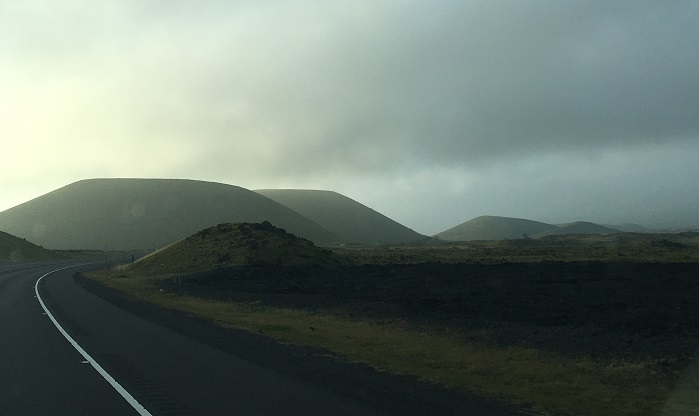
Before heading south to see the Kilauea crater (before this fall’s eruption), let’s hear more about volcanoes from Thor:
“Earth’s crust is composed of continents and ocean floor. Continental crust is thicker than ocean crust, is less dense, and is more buoyant. I know it sounds weird to talk about a continent as being buoyant, but in fact both the ocean crust and continental crust literally float on a viscous layer called the aesthenosphere. Ocean crust is produced at mid-oceanic ridges which are like long underwater volcanic mountain chains and is consumed at subduction zones where it dives back into the interior of the Earth. So, ocean crust is continuously being made and consumed while the more buoyant continents bob around like corks in a tub, occasionally colliding and creating mountain chains. This process is called plate tectonics.
“Ocean crust is made of a type of rock called basalt. It is black, dense, and when molten tends flow rather freely, like warm honey. When an oceanic basaltic volcano erupts, it tends to do so rather quietly, i.e. without a big explosion. The lava is so fluid that it does not allow the buildup of pressure underneath. It simply flows out of the crater and travels until it finally cools off or hits water. As a lava flow cools, the surface forms a skin that wrinkles as the warmer lava flows beneath. That is why rocks in Hawaii often have a “ropy” texture. Because the lava is so runny, basaltic volcanoes like Hawaiian volcanoes are broad and spread out.
“Volcanoes on continents, on the other hand, tend to be more explosive and conical in shape. This is because the continents are composed of a rock like granite, which when molten, is much more viscous than molten basalt. If molten basalt is like warm honey, then molten granite is like putty and is viscous enough to allow a lot of pressure to build up before it explodes violently, kind of like a big sneeze. The spray from the sneeze becomes volcanic ash. You can stand more or less safely by an oceanic volcano and watch the lava bubble out. You don’t want to be anywhere near a continental volcano that is about to erupt.”
On our first visit to the caldera April, it looked Madame Pele was letting off some steam, but no one knew she was gearing up for action.
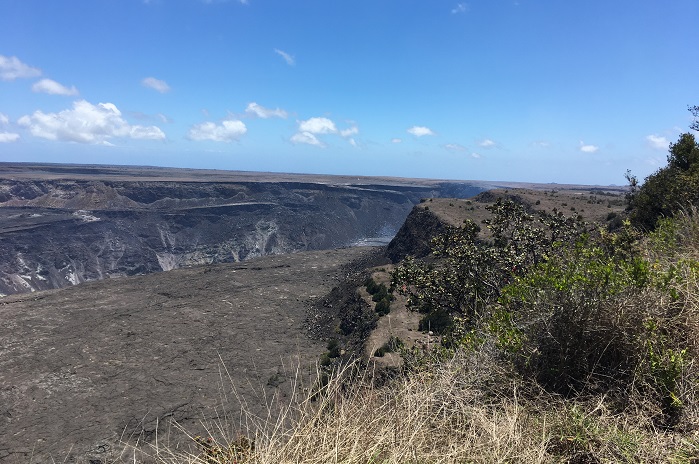
I was ready for the vog at the caldera, not to mention Covid19 virus.
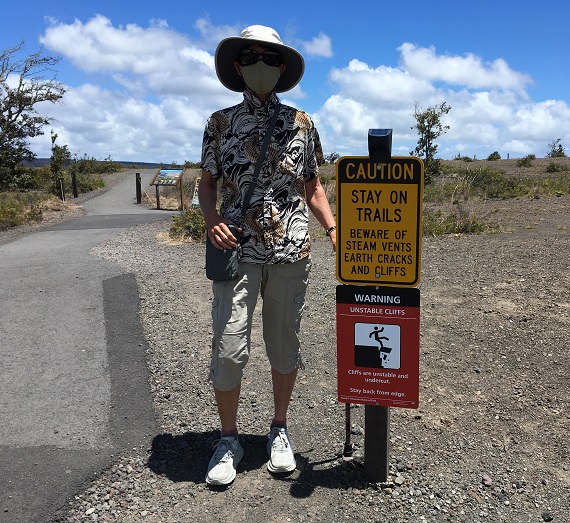
Smooth pahoehoe lava from the major 2018 eruption. Some of the photos above show the more jagged a’a lava.
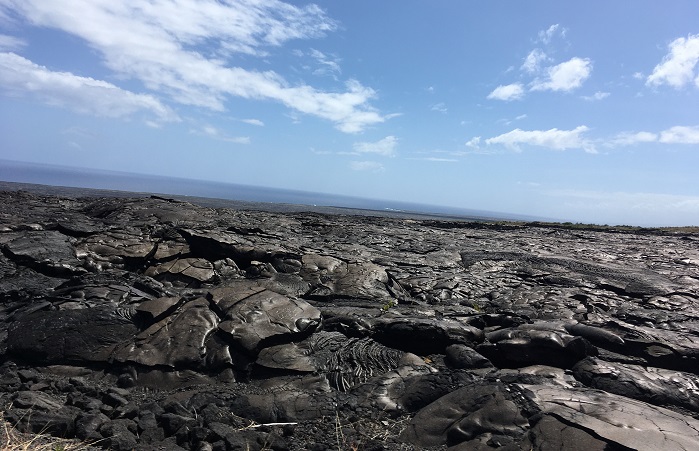
Sometimes the lava hardens into ropy shapes.
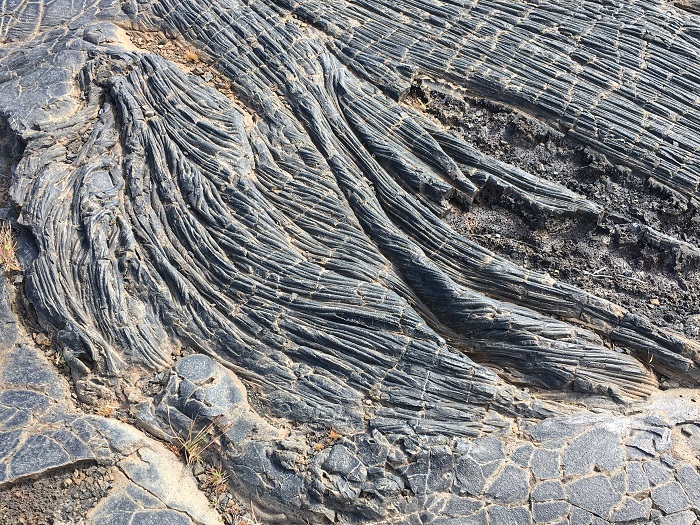
Despite the harsh environment of little soil, the early arrivals from Polynesia managed to thrive and create stories and art, like these petroglyphs on the plain below Kilauea.
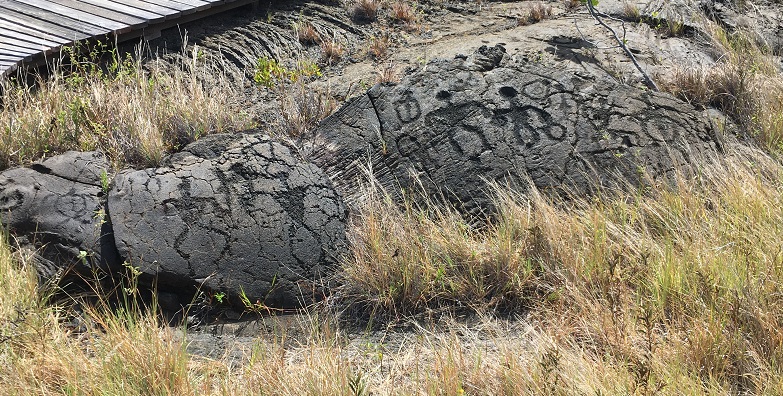
“Life will find a way.”
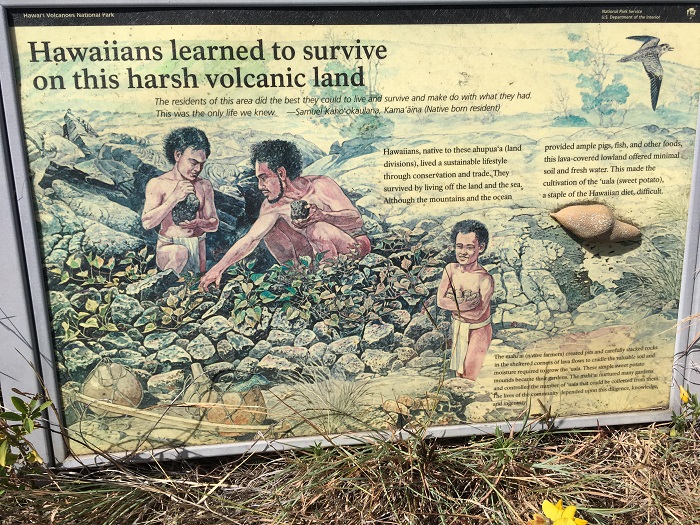
The endemic nene geese are curious about visitors, and thankfully protected.
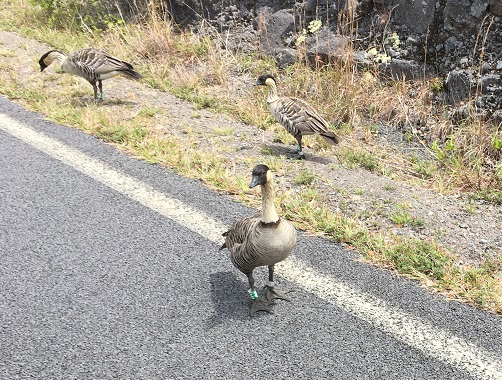
Goats arrived with the early settlers, and now run wild, foraging over the lava fields for sparse vegetation.
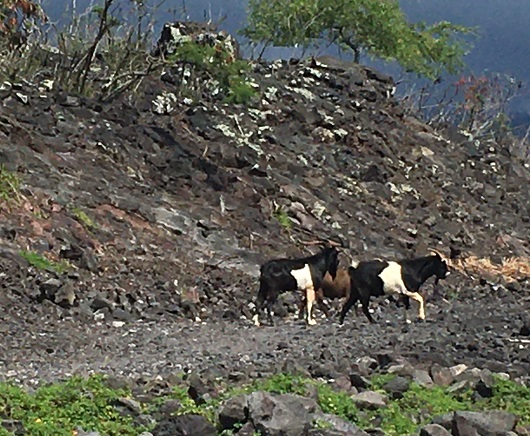
More from Thor:
“The Hawaiian island chain is the result of the Pacific Ocean plate moving over a rising magma (molten rock) plume deep within Earth. As the plate has moved over this stationary plume, it created a string of islands with Ni’ihau and Kauai as the oldest and the Big Island as the youngest. In fact, the Big Island is still growing, and happily consuming the occasional housing development. Meanwhile a new underwater volcano is forming southeast of the Big Island called Lo’ihi. Someday this will pop up as the newest Hawaiian island and the Big Island will be able to take a break and get pleasingly weathered into vast canyons like those seen on Kauai. I can hardly wait!”
For contrast, here is the Waimea Canyon on the oldest of the islands, Kauai:
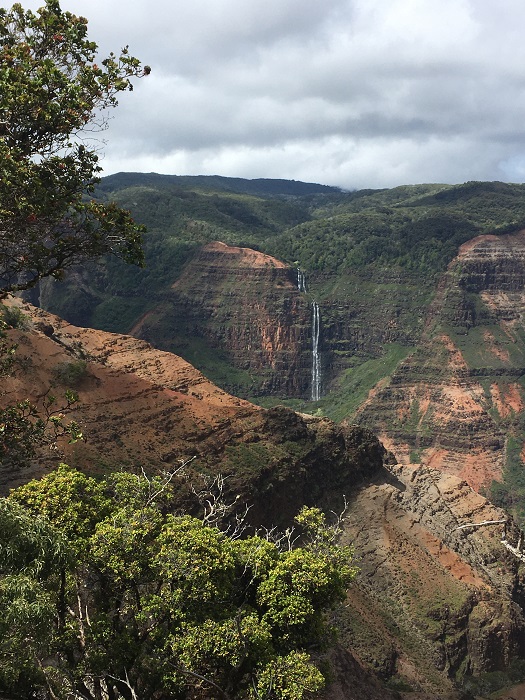
We bid farewell to the beautiful Big Island, with thanks. “Mahalo! Aloha!”
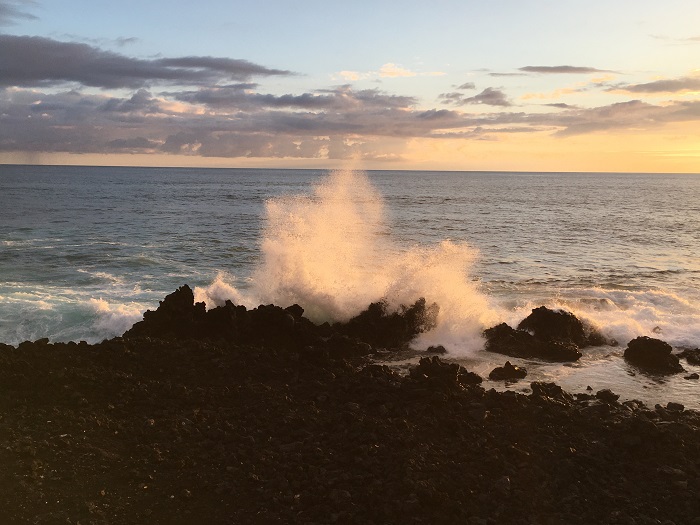
*****
You will find The Rambling Writer’s blog posts here every Saturday. Sara’s latest novel from Book View Café is Pause, a First Place winner of the Chanticleer Somerset Award and an International Pulpwood Queens Book Club selection. “A must-read novel about friendship, love, and killer hot flashes.” (Mindy Klasky). Sign up for her quarterly email newsletter at www.sarastamey.com

1 thought on “The Rambling Writer’s Hawaii, part 4: Lots of Lava!”